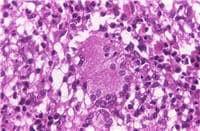Mycobacterium abscessus in Healthcare Settings
General information about Mycobacterium abscessus
Mycobacterium abscessus [mī–kō–bak–tair–ee–yum ab–ses–sus] (also called M. abscessus) is a bacterium distantly related to the ones that cause tuberculosis and Hansen’s Disease (Leprosy). It is part of a group of environmental mycobacteria and is found in water, soil, and dust. It has been known to contaminate medications and products, including medical devices.
M. abscessus can cause a variety of infections. Healthcare-associated infections due to this bacterium are usually of the skin and the soft tissues under the skin. It is also a cause of serious lung infections in persons with various chronic lung diseases, such as cystic fibrosis.
People with open wounds or who receive injections without appropriate skin disinfection may be at risk for infection by M. abscessus. Rarely, individuals with underlying respiratory conditions or impaired immune systems are at risk of lung infection.
Mycobacterium abscessus is a bacterium distantly related to the ones that cause tuberculosis and leprosy. It is part of a group known as rapidly growing mycobacteria and is found in water, soil, and dust. It has been known to contaminate medications and products, including medical devices.
Symptoms of Mycobacterium abscessus

Mycobacterium abscessus
Skin infected with M. abscessus is usually red, warm, tender to the touch, swollen, and/or painful. Infected areas can also develop boils or pus-filled vesicles. Other signs of M. abscessus infection are fever, chills, muscle aches, and a general feeling of illness. A medical provider should evaluate the infection to determine if it may be due to M. abscessus.
Diagnosis of Mycobacterium abscessus
For a definite diagnosis, the organism has to be cultured from the infection site or, in severe cases, from a blood culture.
Diagnosis is made by growing this bacterium in the laboratory from a sample of the pus or biopsy of the infected area. When the infection is severe, the bacterium can be found in the blood and isolated from a blood sample. To make the diagnosis, your healthcare provider will have to take a sample from the infected area and/or blood and send it to a laboratory for identification. It is important that persons who have any evidence of infection at a site where they received procedures, such as surgery or injections, let their doctors know so the appropriate tests can be done.
Transmission of Mycobacterium abscessus
Transmission of M. abscessus can occur in several ways. Infection with M. abscessus is usually caused by injections of substances contaminated with the bacterium or through invasive medical procedures employing contaminated equipment or material. Infection can also occur after accidental injury where the wound is contaminated by soil. There is very little risk of transmission from person to person.
Prevention of Mycobacterium abscessus
Anyone who touches or cares for the infected site should wash their hands carefully with soap and water. Patients should follow all instructions given by their healthcare provider following any surgery or medical procedure. Avoid receiving procedures or injections by unlicensed persons.
Treatment of Mycobacterium abscessus
Treatment of infections due to M. abscessus consists of draining collections of pus or removing the infected tissue and administering the appropriate combination of antibiotics for a prolonged period of time. Infection with this bacterium usually does not improve with the usual antibiotics used to treat skin infections. Testing the bacteria against different antibiotics is helpful in guiding doctors to the most appropriate treatment for each patient.